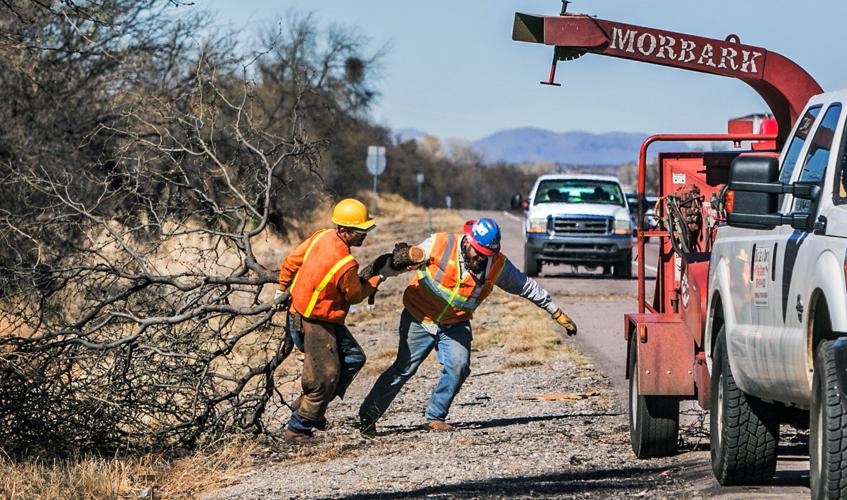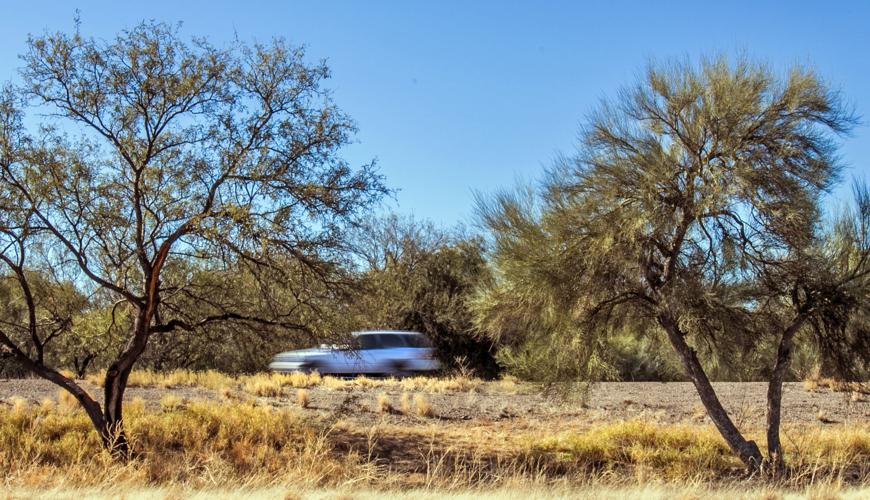Over the next couple months, a contractor hired by the Arizona Department of Transportation will be slowly making its way north from Nogales along Interstate 19, clearing trees, shrubs and other materials within 30 feet of the highway.
ADOT’s reasoning is simple: trees close to roads can turn an otherwise unexceptional loss of vehicle control into a fatal or incapacitating incident.
As noted by the Federal Highway Administration, “Trees are the single most commonly struck objects in serious roadside crashes,” and such crashes annually account for more than 4,000 fatalities and 100,000 injuries.
I-19 has seen more than its fair share of those fatalities, according to a July 2016 ADOT study on tree-involved crashes obtained by the Road Runner. The agency looked at crashes on just over 500 miles of roadway around the state between 2010 and 2014, of which I-19 accounted for a little over 11 percent of total mileage.
However, four of the nine fatalities in the study period were along I-19, as were a third of the 22 serious, incapacitating crashes and 30 percent of all 416 tree-involved incidents.
Those high figures are why I-19 and Arizona 87 near Payson were the first selected for the federally funded effort. Each project will cost around $1 million, according to contract information. Other top priorities include nearby stretches of Interstate 10, Arizona 92 south of Sierra Vista and Arizona 79 northwest of Oracle Junction.
“Work for other locations has yet to be scheduled,” ADOT spokesman Steve Elliott wrote in an email. “But the plan is to address all of them in upcoming years.”
But if the I-19 experience is any indication, ADOT may run into some opposition.
While it is unlikely to slow or alter the project, a number of Green Valley residents have taken issue with the removal of trees along the highway, which bisects their unincorporated community, and proposed alternatives to improving safety along I-19.
At a Jan. 20 meeting, roughly 100 people — almost unanimous in their opposition to the project — gave ADOT officials a piece of their minds, as reported in the Green Valley News.
Green Valley resident Barbara Blake, a critic who attended the meeting, later told the Road Runner that when those who supported the project were asked to raise their hands, just one went up.
Don Weaver, president of the Green Valley Council, said many attendees were upset at the lack of public outreach before the project got going and the potential environmental or aesthetic impacts of losing the trees themselves. He clarified that he was simply summarizing views heard, not taking a position on them.
For Blake, dropping the speed limit along I-19 and increasing enforcement could accomplish ADOT’s safety goals without removing trees. “It’s 65 mph in there,” she said of the lower limit near Green Valley. “Nobody goes 65.”
Gary Harkless, another attendee, agreed, saying that a reduced speed limit — coupled with zero-tolerance enforcement — would also cut down on noise. Additionally, Harkless and other residents said that the trees slated to be removed already help cut down on highway noise, which he anticipates rising once they’re gone.
Harkless was also skeptical that the data cited by ADOT didn’t paint as bleak a picture as suggested by the agency. To the degree that there is a problem with tree-related crashes, Harkless suggested that may simply be a reflection of there being more crashes in general along I-19.
Elliott said his agency appreciates “the beauty trees add to highways and the connection people have with them,” but added: “ADOT’s first priority must be public safety.”
In response to the lower speed limit proposals, Elliott said that dropping it on I-19 to 55 mph would create an “unacceptable safety risk” due to the larger discrepancy between law-abiding drivers and the many drivers who would likely stick to interstate speeds.
Elliott also addressed the relationship between roadside trees and noise, which he said research shows is minimal.
“According to the Federal Highway Administration, a stand of trees 100 feet thick and 20 feet tall would reduce sound by five decibel points, which is barely a whisper,” he wrote.
Despite the opposition in Green Valley, Elliott said the project is expected to be finished by March. While acknowledging the concerns raised, he also said that the 30-foot swath would spare many trees, though there is not an exact count of trees likely to be removed.
What do you think? Check out the poll in the online version of this story to weigh in.
DOWN THE ROAD
- Starting Wednesday morning, traffic on West Ina Road between Interstate 10 and North Silverbell Road will be shifted to the north side of the road and reduced to one lane in each direction to accommodate the massive Ina interchange project. The road’s I-10 intersection will shut down for over two years starting Feb. 15.
- The east side of the West Nebraska Street-South 12th Avenue intersection will be closed to traffic Monday and Tuesday to accommodate underground electrical work. On Wednesday and Thursday, the west side of the intersection will be closed. Both closures will last from 7 a.m. to 5 p.m. Both directions of 12th will remain open. The work is part of the larger 12th Avenue reconstruction project, on which milling and paving is expected to start in late February and finish in March.





